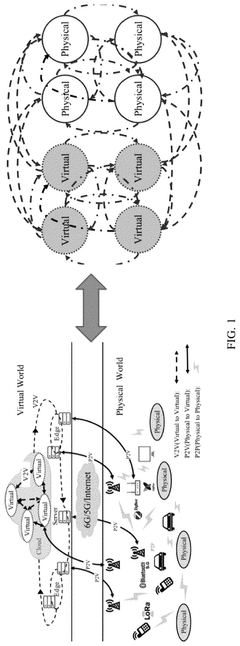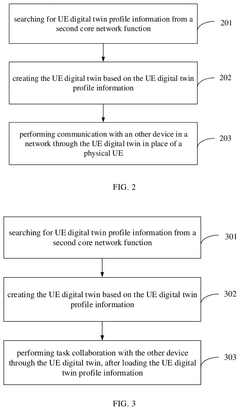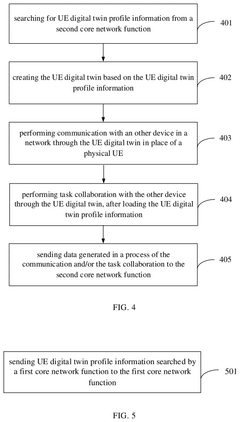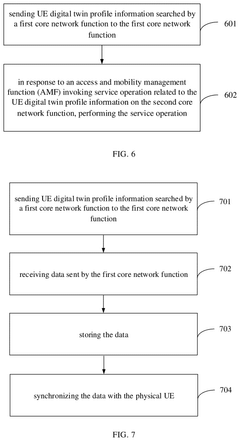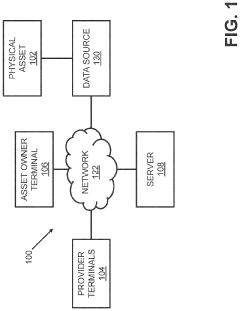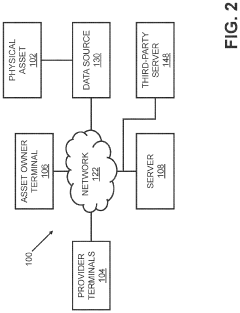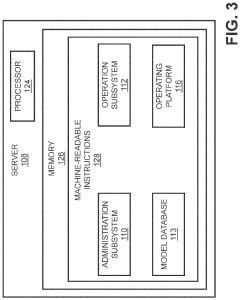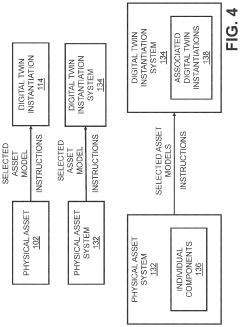Exploring the Integration of 5G UC with Digital Twin Technology
JUL 18, 202510 MIN READ
Generate Your Research Report Instantly with AI Agent
Patsnap Eureka helps you evaluate technical feasibility & market potential.
5G UC and Digital Twin Evolution
The evolution of 5G UC (Ultra-Reliable Low-Latency Communication) and Digital Twin technology represents a significant leap in the convergence of advanced telecommunications and virtual modeling. 5G UC, a key component of 5G networks, has been developing rapidly since its inception, focusing on providing ultra-reliable and low-latency communication for critical applications. This technology has progressed from theoretical concepts to practical implementations, with major milestones including the standardization of 5G UC specifications by 3GPP and successful field trials by leading telecom operators.
Digital Twin technology, on the other hand, has its roots in product lifecycle management and has evolved from simple digital representations to complex, real-time simulations of physical assets. The concept was first introduced in the early 2000s and has since expanded across various industries, including manufacturing, healthcare, and smart cities. Key developments in Digital Twin technology include the integration of IoT sensors, advanced data analytics, and machine learning algorithms to enhance the accuracy and predictive capabilities of digital models.
The convergence of 5G UC and Digital Twin technologies began to gain traction in the late 2010s, as industries recognized the potential of combining ultra-reliable, low-latency communication with high-fidelity digital representations. This integration has been driven by the increasing demand for real-time monitoring, control, and optimization of complex systems in industries such as manufacturing, healthcare, and smart infrastructure.
Significant milestones in this integration include the first successful demonstrations of 5G-enabled Digital Twins in industrial settings, showcasing the ability to create near-real-time virtual replicas of production lines and processes. These early implementations highlighted the potential for improved efficiency, predictive maintenance, and remote operations enabled by the synergy between 5G UC and Digital Twin technologies.
As the technologies continue to mature, we are witnessing a shift towards more sophisticated and interconnected Digital Twin ecosystems powered by 5G UC networks. This evolution is characterized by the development of edge computing capabilities, advanced AI algorithms for data processing, and the creation of standardized protocols for seamless integration between 5G networks and Digital Twin platforms.
Looking ahead, the trajectory of 5G UC and Digital Twin integration is poised to revolutionize various sectors. Future developments are expected to focus on enhancing the scalability and interoperability of these integrated systems, enabling the creation of complex, multi-layered Digital Twins that can simulate entire supply chains, cities, or even ecosystems. The ongoing research in areas such as network slicing, AI-driven predictive analytics, and quantum computing is likely to further accelerate the capabilities and applications of this integrated technology stack.
Digital Twin technology, on the other hand, has its roots in product lifecycle management and has evolved from simple digital representations to complex, real-time simulations of physical assets. The concept was first introduced in the early 2000s and has since expanded across various industries, including manufacturing, healthcare, and smart cities. Key developments in Digital Twin technology include the integration of IoT sensors, advanced data analytics, and machine learning algorithms to enhance the accuracy and predictive capabilities of digital models.
The convergence of 5G UC and Digital Twin technologies began to gain traction in the late 2010s, as industries recognized the potential of combining ultra-reliable, low-latency communication with high-fidelity digital representations. This integration has been driven by the increasing demand for real-time monitoring, control, and optimization of complex systems in industries such as manufacturing, healthcare, and smart infrastructure.
Significant milestones in this integration include the first successful demonstrations of 5G-enabled Digital Twins in industrial settings, showcasing the ability to create near-real-time virtual replicas of production lines and processes. These early implementations highlighted the potential for improved efficiency, predictive maintenance, and remote operations enabled by the synergy between 5G UC and Digital Twin technologies.
As the technologies continue to mature, we are witnessing a shift towards more sophisticated and interconnected Digital Twin ecosystems powered by 5G UC networks. This evolution is characterized by the development of edge computing capabilities, advanced AI algorithms for data processing, and the creation of standardized protocols for seamless integration between 5G networks and Digital Twin platforms.
Looking ahead, the trajectory of 5G UC and Digital Twin integration is poised to revolutionize various sectors. Future developments are expected to focus on enhancing the scalability and interoperability of these integrated systems, enabling the creation of complex, multi-layered Digital Twins that can simulate entire supply chains, cities, or even ecosystems. The ongoing research in areas such as network slicing, AI-driven predictive analytics, and quantum computing is likely to further accelerate the capabilities and applications of this integrated technology stack.
Market Demand Analysis
The integration of 5G UC (Ultra-Reliable Low-Latency Communication) with Digital Twin technology is poised to revolutionize various industries, driving significant market demand. This convergence addresses critical needs in sectors such as manufacturing, healthcare, smart cities, and autonomous vehicles, where real-time data processing and ultra-low latency are paramount.
In the manufacturing sector, the combination of 5G UC and Digital Twin technology enables real-time monitoring and optimization of production processes. This integration allows for predictive maintenance, reducing downtime and increasing overall equipment effectiveness. The market for smart manufacturing solutions leveraging these technologies is expected to grow substantially, as companies seek to improve efficiency and reduce operational costs.
The healthcare industry stands to benefit greatly from this technological integration. Remote surgery and telemedicine applications require the high reliability and low latency provided by 5G UC, while Digital Twin technology enables accurate simulations of medical procedures and patient monitoring. The demand for these advanced healthcare solutions is rising, driven by the need for improved patient care and the increasing adoption of telehealth services.
Smart cities represent another significant market opportunity for 5G UC and Digital Twin integration. Urban planners and city administrators are increasingly looking to implement intelligent transportation systems, energy management, and public safety solutions. The combination of these technologies allows for real-time monitoring and optimization of city infrastructure, leading to improved resource allocation and enhanced citizen services.
The automotive industry, particularly in the realm of autonomous vehicles, is a key driver of market demand for 5G UC and Digital Twin integration. These technologies enable vehicle-to-everything (V2X) communication, real-time traffic management, and advanced driver assistance systems. As the automotive industry continues its shift towards autonomous and connected vehicles, the demand for these integrated solutions is expected to surge.
Industrial IoT applications across various sectors are also fueling market growth. The integration of 5G UC and Digital Twin technology enables the creation of highly responsive and adaptive industrial systems, improving productivity and reducing operational risks. This has led to increased demand from sectors such as energy, utilities, and logistics.
The market for 5G UC and Digital Twin integration is further bolstered by the growing emphasis on sustainability and environmental management. These technologies enable more efficient resource utilization and energy management, aligning with global initiatives for reducing carbon footprints and promoting sustainable practices across industries.
As organizations increasingly recognize the potential of this technological integration to drive innovation and competitive advantage, the market demand is expected to experience robust growth in the coming years. This trend is likely to be reinforced by ongoing advancements in both 5G and Digital Twin technologies, as well as the development of new use cases and applications across various industries.
In the manufacturing sector, the combination of 5G UC and Digital Twin technology enables real-time monitoring and optimization of production processes. This integration allows for predictive maintenance, reducing downtime and increasing overall equipment effectiveness. The market for smart manufacturing solutions leveraging these technologies is expected to grow substantially, as companies seek to improve efficiency and reduce operational costs.
The healthcare industry stands to benefit greatly from this technological integration. Remote surgery and telemedicine applications require the high reliability and low latency provided by 5G UC, while Digital Twin technology enables accurate simulations of medical procedures and patient monitoring. The demand for these advanced healthcare solutions is rising, driven by the need for improved patient care and the increasing adoption of telehealth services.
Smart cities represent another significant market opportunity for 5G UC and Digital Twin integration. Urban planners and city administrators are increasingly looking to implement intelligent transportation systems, energy management, and public safety solutions. The combination of these technologies allows for real-time monitoring and optimization of city infrastructure, leading to improved resource allocation and enhanced citizen services.
The automotive industry, particularly in the realm of autonomous vehicles, is a key driver of market demand for 5G UC and Digital Twin integration. These technologies enable vehicle-to-everything (V2X) communication, real-time traffic management, and advanced driver assistance systems. As the automotive industry continues its shift towards autonomous and connected vehicles, the demand for these integrated solutions is expected to surge.
Industrial IoT applications across various sectors are also fueling market growth. The integration of 5G UC and Digital Twin technology enables the creation of highly responsive and adaptive industrial systems, improving productivity and reducing operational risks. This has led to increased demand from sectors such as energy, utilities, and logistics.
The market for 5G UC and Digital Twin integration is further bolstered by the growing emphasis on sustainability and environmental management. These technologies enable more efficient resource utilization and energy management, aligning with global initiatives for reducing carbon footprints and promoting sustainable practices across industries.
As organizations increasingly recognize the potential of this technological integration to drive innovation and competitive advantage, the market demand is expected to experience robust growth in the coming years. This trend is likely to be reinforced by ongoing advancements in both 5G and Digital Twin technologies, as well as the development of new use cases and applications across various industries.
Technical Challenges
The integration of 5G UC (Ultra-Reliable Low-Latency Communication) with Digital Twin technology presents several significant technical challenges that need to be addressed for successful implementation. One of the primary obstacles is ensuring seamless connectivity and ultra-low latency communication between physical assets and their digital counterparts. The stringent requirements of 5G UC, including sub-millisecond latency and near-perfect reliability, pose substantial difficulties in maintaining consistent performance across diverse environments and use cases.
Data synchronization and real-time updates between physical systems and digital twins represent another major challenge. The vast amount of data generated by IoT sensors and devices must be efficiently processed, transmitted, and integrated into the digital twin models without compromising accuracy or introducing delays. This requires advanced data management techniques and robust edge computing capabilities to handle the massive influx of information.
Security and privacy concerns also present significant hurdles in the integration process. As digital twins often involve sensitive industrial data and critical infrastructure information, ensuring end-to-end encryption, secure authentication mechanisms, and protection against cyber threats becomes paramount. Implementing comprehensive security measures without impacting the performance and latency requirements of 5G UC adds another layer of complexity to the integration efforts.
Interoperability and standardization issues further complicate the integration landscape. The lack of unified protocols and standards for digital twin implementations across different industries and platforms can lead to compatibility problems when integrating with 5G UC networks. Developing common frameworks and APIs that allow seamless communication between diverse digital twin systems and 5G infrastructure is crucial for widespread adoption.
Scalability and resource management pose additional challenges, particularly in large-scale industrial environments. As the number of connected devices and digital twin models grows, efficiently allocating network resources, managing bandwidth, and maintaining quality of service become increasingly complex. Optimizing network slicing techniques and implementing intelligent resource allocation algorithms are essential to address these scalability concerns.
The integration of AI and machine learning capabilities into the combined 5G UC and digital twin ecosystem presents its own set of challenges. Developing accurate predictive models, implementing real-time decision-making algorithms, and ensuring the reliability of AI-driven insights in mission-critical applications require significant advancements in edge AI technologies and distributed computing architectures.
Lastly, the cost and complexity of deploying and maintaining integrated 5G UC and digital twin systems remain significant barriers to widespread adoption. Overcoming these challenges requires innovative approaches to reduce implementation costs, simplify system management, and demonstrate clear ROI for businesses across various industries.
Data synchronization and real-time updates between physical systems and digital twins represent another major challenge. The vast amount of data generated by IoT sensors and devices must be efficiently processed, transmitted, and integrated into the digital twin models without compromising accuracy or introducing delays. This requires advanced data management techniques and robust edge computing capabilities to handle the massive influx of information.
Security and privacy concerns also present significant hurdles in the integration process. As digital twins often involve sensitive industrial data and critical infrastructure information, ensuring end-to-end encryption, secure authentication mechanisms, and protection against cyber threats becomes paramount. Implementing comprehensive security measures without impacting the performance and latency requirements of 5G UC adds another layer of complexity to the integration efforts.
Interoperability and standardization issues further complicate the integration landscape. The lack of unified protocols and standards for digital twin implementations across different industries and platforms can lead to compatibility problems when integrating with 5G UC networks. Developing common frameworks and APIs that allow seamless communication between diverse digital twin systems and 5G infrastructure is crucial for widespread adoption.
Scalability and resource management pose additional challenges, particularly in large-scale industrial environments. As the number of connected devices and digital twin models grows, efficiently allocating network resources, managing bandwidth, and maintaining quality of service become increasingly complex. Optimizing network slicing techniques and implementing intelligent resource allocation algorithms are essential to address these scalability concerns.
The integration of AI and machine learning capabilities into the combined 5G UC and digital twin ecosystem presents its own set of challenges. Developing accurate predictive models, implementing real-time decision-making algorithms, and ensuring the reliability of AI-driven insights in mission-critical applications require significant advancements in edge AI technologies and distributed computing architectures.
Lastly, the cost and complexity of deploying and maintaining integrated 5G UC and digital twin systems remain significant barriers to widespread adoption. Overcoming these challenges requires innovative approaches to reduce implementation costs, simplify system management, and demonstrate clear ROI for businesses across various industries.
Current Integration Solutions
01 Integration of 5G UC and Digital Twin for Industrial Applications
The combination of 5G Ultra-Capacity (UC) networks and Digital Twin technology enables real-time monitoring, control, and optimization of industrial processes. This integration allows for improved efficiency, predictive maintenance, and enhanced decision-making in manufacturing and other industrial sectors.- Integration of 5G UC and Digital Twin for Industrial Applications: The combination of 5G Ultra-Capacity (UC) networks and Digital Twin technology enables real-time monitoring, control, and optimization of industrial processes. This integration allows for improved efficiency, predictive maintenance, and enhanced decision-making in manufacturing and other industrial sectors.
- 5G UC-Enabled Digital Twin for Smart Cities: 5G UC networks facilitate the creation and operation of Digital Twins for urban environments, enabling comprehensive monitoring and management of city infrastructure, traffic flow, energy consumption, and public services. This technology combination supports the development of more efficient and sustainable smart cities.
- Enhanced Healthcare Systems using 5G UC and Digital Twin: The integration of 5G UC and Digital Twin technology in healthcare allows for remote patient monitoring, personalized treatment plans, and virtual medical training. This combination enables real-time data analysis and visualization, improving patient care and medical research outcomes.
- 5G UC-Powered Digital Twin for Autonomous Vehicles: 5G UC networks enable the creation and updating of Digital Twins for autonomous vehicles and transportation systems. This integration supports real-time traffic management, vehicle-to-everything (V2X) communication, and enhanced safety features in self-driving cars and smart transportation networks.
- Security and Privacy in 5G UC-Enabled Digital Twin Systems: As 5G UC and Digital Twin technologies become more prevalent, ensuring data security and privacy becomes crucial. This point focuses on developing robust encryption methods, secure data transmission protocols, and privacy-preserving techniques for Digital Twin applications operating on 5G UC networks.
02 5G UC-Enabled Digital Twin for Smart Cities
5G UC networks facilitate the creation and operation of Digital Twins for urban environments, enabling comprehensive monitoring and management of city infrastructure, traffic, energy systems, and public services. This integration supports the development of more efficient and sustainable smart cities.Expand Specific Solutions03 Enhanced Healthcare Systems using 5G UC and Digital Twin
The combination of 5G UC and Digital Twin technology in healthcare allows for remote patient monitoring, personalized treatment planning, and virtual medical training. This integration improves patient care, reduces costs, and enhances medical education and research capabilities.Expand Specific Solutions04 5G UC-Powered Digital Twin for Autonomous Vehicles
5G UC networks enable the creation and real-time updating of Digital Twins for autonomous vehicles and transportation systems. This integration enhances vehicle-to-everything (V2X) communication, improves safety, and optimizes traffic flow in smart transportation ecosystems.Expand Specific Solutions05 Security and Privacy in 5G UC-Enabled Digital Twin Systems
As 5G UC and Digital Twin technologies become more prevalent, ensuring data security and privacy becomes crucial. This includes developing robust encryption methods, secure data transmission protocols, and privacy-preserving techniques for Digital Twin applications in various sectors.Expand Specific Solutions
Key Industry Players
The integration of 5G UC with Digital Twin technology is in its early stages, with the market showing significant growth potential. The competitive landscape is characterized by a mix of established telecommunications giants and innovative tech companies. Key players like Samsung Electronics, Ericsson, ZTE, and Huawei are leading the charge in 5G infrastructure development, while companies such as Xiaomi and Sony are focusing on consumer applications. The technology's maturity is rapidly advancing, with companies like China Mobile and SK Telecom actively researching and implementing 5G-enabled Digital Twin solutions. As the market evolves, collaborations between telecom providers, hardware manufacturers, and software developers are becoming increasingly crucial for driving innovation and adoption in this space.
Samsung Electronics Co., Ltd.
Technical Solution: Samsung's integration of 5G UC with Digital Twin technology leverages their expertise in both telecommunications and consumer electronics. Their approach focuses on creating a seamless ecosystem that connects smart devices, industrial equipment, and cloud infrastructure. Samsung has developed a comprehensive platform that utilizes 5G's high bandwidth and low latency to enable real-time data transfer and processing for Digital Twin applications[1]. The company's solution incorporates advanced AI algorithms for predictive maintenance and optimization in manufacturing environments[3]. Samsung has also implemented edge computing capabilities to support local processing of Digital Twin data, reducing latency and enhancing privacy[5]. Their platform supports multi-device integration, allowing for the creation of complex Digital Twin ecosystems across various industries.
Strengths: Strong presence in both consumer and industrial markets, extensive R&D capabilities. Weaknesses: Relatively new entrant in the industrial Digital Twin space compared to some competitors.
Telefonaktiebolaget LM Ericsson
Technical Solution: Ericsson's approach to integrating 5G UC with Digital Twin technology focuses on creating a seamless ecosystem for industrial applications. Their solution leverages 5G's network slicing capabilities to provide dedicated virtual networks for different Digital Twin use cases[2]. Ericsson has developed a cloud-native platform that enables real-time data processing and visualization of Digital Twins across various industries. The company's solution incorporates machine learning algorithms for predictive maintenance and optimization of industrial processes[4]. Ericsson has also implemented advanced security measures, including end-to-end encryption and identity management, to ensure data integrity in Digital Twin applications[6].
Strengths: Extensive 5G network expertise, strong partnerships with industrial players. Weaknesses: Less experience in Digital Twin software development compared to some competitors.
Core Innovations
Method and apparatus for communication
PatentPendingUS20250097116A1
Innovation
- The implementation of a method that allows a first core network function to search for and create a UE digital twin profile, enabling communication with other devices in the network through the digital twin instead of the physical UE, thereby enhancing network service availability.
System and method for providing digital twin services from multiple digital twin providers
PatentInactiveUS20220019212A1
Innovation
- A system and method that enables digital twin services for multiple providers, featuring a server with an administration and operation subsystem, capable of receiving and storing asset models, generating reports based on operating history data, and predicting residual life, allowing for a wide range of digital twin applications across various industries.
Regulatory Considerations
The integration of 5G UC (Ultra-Reliable Low-Latency Communication) with Digital Twin technology presents a complex regulatory landscape that requires careful consideration. As this convergence involves critical infrastructure and sensitive data, regulatory bodies worldwide are developing frameworks to ensure security, privacy, and ethical use of these technologies.
One of the primary regulatory concerns is data protection and privacy. The vast amount of real-time data collected and processed by Digital Twins, coupled with the high-speed, low-latency capabilities of 5G UC, raises questions about data ownership, storage, and cross-border data flows. Regulators are working to establish clear guidelines on data handling, retention periods, and consent mechanisms to protect individual and corporate privacy rights.
Spectrum allocation and management for 5G UC is another crucial regulatory aspect. Governments and telecommunications authorities are tasked with efficiently allocating and managing the radio frequency spectrum to support the widespread deployment of 5G networks. This includes considerations for dedicated spectrum for industrial applications and critical communications, which are essential for Digital Twin implementations in sectors such as manufacturing and healthcare.
Cybersecurity regulations play a vital role in safeguarding Digital Twin systems operating on 5G networks. Regulatory bodies are developing standards and protocols to ensure the integrity and resilience of these systems against cyber threats. This includes mandating encryption standards, authentication protocols, and regular security audits for organizations implementing Digital Twin solutions.
Interoperability and standardization are key focus areas for regulators. As the integration of 5G UC and Digital Twin technology spans multiple industries and jurisdictions, there is a push for harmonized standards to ensure seamless communication and data exchange. International bodies such as the ITU and ISO are working on developing global standards to facilitate cross-border and cross-industry adoption.
Liability and accountability frameworks are being established to address potential issues arising from the use of Digital Twins in critical decision-making processes. Regulators are defining guidelines for determining responsibility in cases of system failures or erroneous decisions made based on Digital Twin data, particularly in high-stakes environments like autonomous vehicles or smart city infrastructure.
Environmental regulations are also being considered, particularly regarding the energy consumption of 5G networks and data centers supporting Digital Twin operations. Regulatory bodies are setting energy efficiency standards and encouraging the use of renewable energy sources to mitigate the environmental impact of these technologies.
As the integration of 5G UC and Digital Twin technology continues to evolve, regulatory frameworks will need to remain flexible and adaptive. Ongoing collaboration between industry stakeholders, policymakers, and regulatory bodies will be crucial in developing balanced regulations that foster innovation while ensuring public safety and ethical use of these transformative technologies.
One of the primary regulatory concerns is data protection and privacy. The vast amount of real-time data collected and processed by Digital Twins, coupled with the high-speed, low-latency capabilities of 5G UC, raises questions about data ownership, storage, and cross-border data flows. Regulators are working to establish clear guidelines on data handling, retention periods, and consent mechanisms to protect individual and corporate privacy rights.
Spectrum allocation and management for 5G UC is another crucial regulatory aspect. Governments and telecommunications authorities are tasked with efficiently allocating and managing the radio frequency spectrum to support the widespread deployment of 5G networks. This includes considerations for dedicated spectrum for industrial applications and critical communications, which are essential for Digital Twin implementations in sectors such as manufacturing and healthcare.
Cybersecurity regulations play a vital role in safeguarding Digital Twin systems operating on 5G networks. Regulatory bodies are developing standards and protocols to ensure the integrity and resilience of these systems against cyber threats. This includes mandating encryption standards, authentication protocols, and regular security audits for organizations implementing Digital Twin solutions.
Interoperability and standardization are key focus areas for regulators. As the integration of 5G UC and Digital Twin technology spans multiple industries and jurisdictions, there is a push for harmonized standards to ensure seamless communication and data exchange. International bodies such as the ITU and ISO are working on developing global standards to facilitate cross-border and cross-industry adoption.
Liability and accountability frameworks are being established to address potential issues arising from the use of Digital Twins in critical decision-making processes. Regulators are defining guidelines for determining responsibility in cases of system failures or erroneous decisions made based on Digital Twin data, particularly in high-stakes environments like autonomous vehicles or smart city infrastructure.
Environmental regulations are also being considered, particularly regarding the energy consumption of 5G networks and data centers supporting Digital Twin operations. Regulatory bodies are setting energy efficiency standards and encouraging the use of renewable energy sources to mitigate the environmental impact of these technologies.
As the integration of 5G UC and Digital Twin technology continues to evolve, regulatory frameworks will need to remain flexible and adaptive. Ongoing collaboration between industry stakeholders, policymakers, and regulatory bodies will be crucial in developing balanced regulations that foster innovation while ensuring public safety and ethical use of these transformative technologies.
Cybersecurity Implications
The integration of 5G UC (Ultra-Reliable Low-Latency Communication) with Digital Twin technology introduces significant cybersecurity implications that must be carefully considered. As these technologies converge, the attack surface expands, necessitating robust security measures to protect sensitive data and critical infrastructure.
One of the primary concerns is the increased vulnerability to data breaches. The vast amount of real-time data collected and transmitted by Digital Twins, coupled with the high-speed, low-latency capabilities of 5G UC, creates an attractive target for cybercriminals. This data, often containing proprietary information or critical operational insights, requires enhanced encryption and secure communication protocols to prevent unauthorized access and interception.
The distributed nature of 5G networks, particularly in edge computing scenarios, introduces new security challenges. As computational processes move closer to the data source, traditional centralized security models may become less effective. This shift demands the implementation of distributed security architectures and advanced threat detection mechanisms capable of operating in real-time across the entire network.
Identity management and access control become more complex in this integrated environment. The multitude of devices, sensors, and systems involved in Digital Twin implementations, all connected via 5G networks, requires sophisticated authentication mechanisms. Zero-trust security models and continuous authentication protocols may need to be adopted to ensure that only authorized entities can access and manipulate Digital Twin data and controls.
The potential for physical-cyber attacks also increases with this integration. Malicious actors could potentially exploit vulnerabilities in the Digital Twin to manipulate physical systems, leading to disruptions or damage in the real world. This necessitates the development of robust anomaly detection systems and fail-safe mechanisms to prevent unauthorized changes from propagating from the digital to the physical realm.
Furthermore, the real-time nature of 5G UC and Digital Twin interactions introduces timing-based security concerns. Attacks that manipulate or delay data transmission could have severe consequences in time-critical applications. Implementing secure time synchronization protocols and developing resilient systems capable of detecting and mitigating timing attacks becomes crucial.
As organizations adopt these integrated technologies, they must also address regulatory compliance and data sovereignty issues. The global nature of 5G networks and the potential for Digital Twins to operate across borders raise questions about data localization and compliance with varying international cybersecurity standards. This may require the development of new frameworks for managing data flows and ensuring compliance in a highly interconnected ecosystem.
One of the primary concerns is the increased vulnerability to data breaches. The vast amount of real-time data collected and transmitted by Digital Twins, coupled with the high-speed, low-latency capabilities of 5G UC, creates an attractive target for cybercriminals. This data, often containing proprietary information or critical operational insights, requires enhanced encryption and secure communication protocols to prevent unauthorized access and interception.
The distributed nature of 5G networks, particularly in edge computing scenarios, introduces new security challenges. As computational processes move closer to the data source, traditional centralized security models may become less effective. This shift demands the implementation of distributed security architectures and advanced threat detection mechanisms capable of operating in real-time across the entire network.
Identity management and access control become more complex in this integrated environment. The multitude of devices, sensors, and systems involved in Digital Twin implementations, all connected via 5G networks, requires sophisticated authentication mechanisms. Zero-trust security models and continuous authentication protocols may need to be adopted to ensure that only authorized entities can access and manipulate Digital Twin data and controls.
The potential for physical-cyber attacks also increases with this integration. Malicious actors could potentially exploit vulnerabilities in the Digital Twin to manipulate physical systems, leading to disruptions or damage in the real world. This necessitates the development of robust anomaly detection systems and fail-safe mechanisms to prevent unauthorized changes from propagating from the digital to the physical realm.
Furthermore, the real-time nature of 5G UC and Digital Twin interactions introduces timing-based security concerns. Attacks that manipulate or delay data transmission could have severe consequences in time-critical applications. Implementing secure time synchronization protocols and developing resilient systems capable of detecting and mitigating timing attacks becomes crucial.
As organizations adopt these integrated technologies, they must also address regulatory compliance and data sovereignty issues. The global nature of 5G networks and the potential for Digital Twins to operate across borders raise questions about data localization and compliance with varying international cybersecurity standards. This may require the development of new frameworks for managing data flows and ensuring compliance in a highly interconnected ecosystem.
Unlock deeper insights with Patsnap Eureka Quick Research — get a full tech report to explore trends and direct your research. Try now!
Generate Your Research Report Instantly with AI Agent
Supercharge your innovation with Patsnap Eureka AI Agent Platform!
